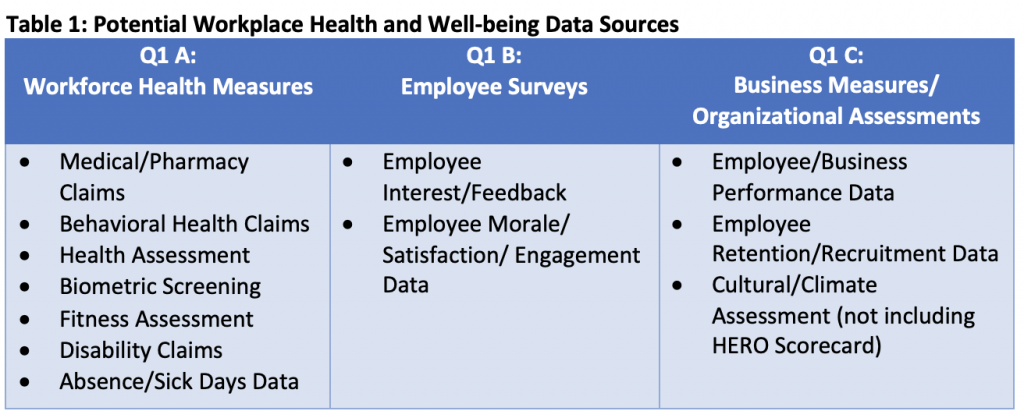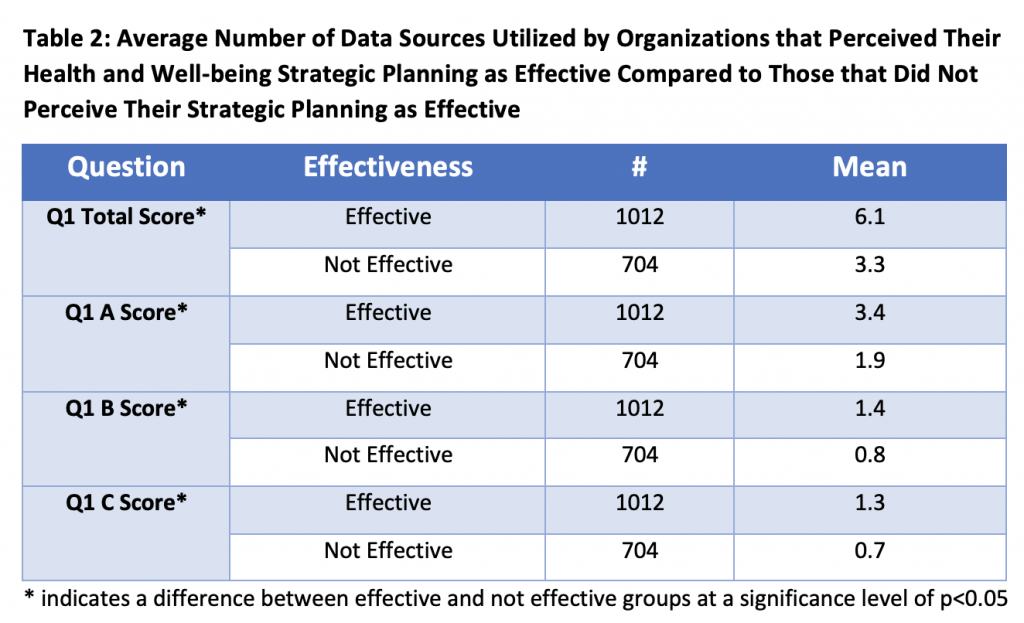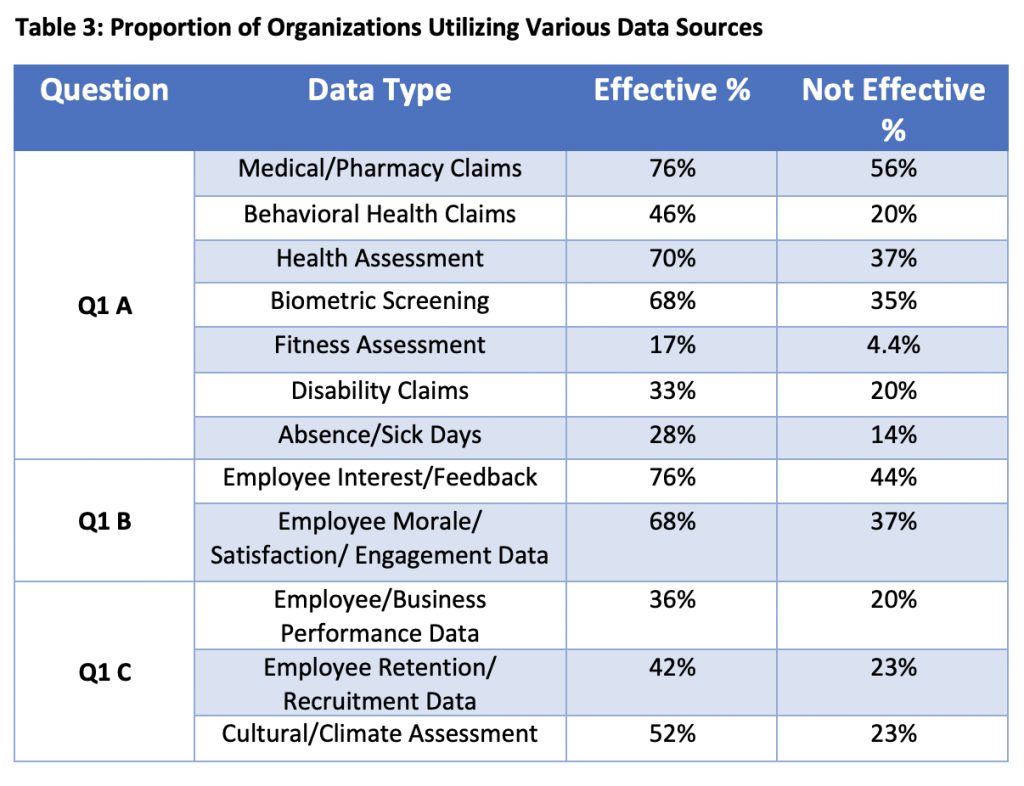
Jenna is a Health Management Consultant with Trion Group, a Marsh & McLennan Agency LLC where she works with various different types of clients to provide strategic data-driven consultation. She has a Master’s of Education focused in Nutrition Education and Consumer Sciences and a Bachelor’s in Health Education and Promotion, along with a Master Certified Health Education Specialist designation
Introduction: Data are important to the development of an effective worksite health and well-being (HWB) strategy. Unfortunately, many organizations do not leverage data to develop and evaluate their programs. Instead, HWB initiatives are commonly implemented in an ad hoc way without consideration of the needs of their employees and what will be most effective for the organization1. Data collection and evaluation have been shown to lead to successful HWB program implementation. Data can help identify gaps that need to be filled in the services provided and initiatives implemented, as well as to determine clear objectives and prioritize interventions and activities specific to the organization1. For example, a review of HWB data can help determine appropriate programming for the population and track effectiveness of the programs implemented.
In addition to using data to make program implementation decisions, qualitative results such as program satisfaction surveys and testimonials can be collected and used to sustain program engagement and to engage new program eligible employees. The continued use of quantitative data can also allow for cohort analysis looking at participants claims experience year-over-year to show the value of the program from a health improvement and cost mitigation standpoint.
This commentary aims to explore how the use of data in strategic planning of a company’s HWB program influences perceived effectiveness of the organization’s strategic planning process for HWB. An analysis was performed using data from the HERO Scorecard database. There were 1,716 unique organizations that completed all relevant sections of Version 4 of the HERO Scorecard as of December 31, 2020. In addition to assessing the influence of data collection on perceived effectiveness of an organization’s HWB strategic plan, this commentary also explored the types of HWB data with the greatest influence on perceived effectiveness.
Organizations were grouped into two categories based on the perceived effectiveness of their HWB strategic planning process (effective = effective + very effective response options and not effective = not very effective + not at all effective response options). Of the 1,716 completers, 1,012 (59%) of the organizations perceived their strategic planning process for HWB as effective. Table 1 provides an overview of the response options of data sources that organizations could select as actively using in their strategic planning of their HWB programs.

Analysis Method: The differences in the use of data between organizations that classified their strategic planning process for HWB as effective vs. those that classified as not effective were assessed using independent samples t-tests. Mean comparisons were made between the use of all data sources, as well as specifically for workforce health measures (Q1A), employee surveys (Q1B), and business measures/organizational assessments (Q1C). Additionally, comparisons were made between groups to determine if there were specific data types that most impacted an organization’s perceived effectiveness of their HWB strategic planning process.


Analysis Findings:
The findings indicate that those who perceived their strategic planning process as effective collected data on significantly more HWB measures overall than those who found their strategic planning process not effective. Specifically, those that found their strategic planning process effective use a mean of 6.1 data sources, whereas organizations that perceive their strategic planning process not effective use on average 3.3 data sources.
Similar results were found when assessing the use of specific types of data. Specifically, organizations that perceive their HWB strategic planning as effective leverage workforce health measures (3.4 vs. 1.9), employee survey measures (1.4 vs. 0.8), and business measures/organizational assessment (1.3 vs.0.7) more than those that do not find their strategic planning process effective.
The most often employed data source for both groups was medical/pharmacy claims, and the least often utilized data sources for both were fitness assessments and absence sick days. The biggest differential reliance on data sources related to the use of health assessments (utilized by 70% of organizations that perceived their HWB strategic plan as effective), employee interest/feedback surveys employee morale/ satisfaction/ engagement data (68%), and cultural/climate assessments.
Conclusion: An effective strategic plan requires the use of meaningful data collection and evaluation to improve worksite HWB initiatives. Collecting and leveraging multiple sources of data that provide unique insights appears to contribute to perceptions of HWB strategic plan as effective.
A key recommendation, supported by the results of this report, is to use the annual Scorecard to help organizations collect data on their HWB initiatives and better understand how leveraging their data can advance their HWB initiatives.
Sources:
Smith, H. (2019, September 19). How to develop an effective health and wellbeing strategy. HRZone. https://www.hrzone.com/lead/strategy/how-to-develop-an-effective-health-and-wellbeing-strategy.
